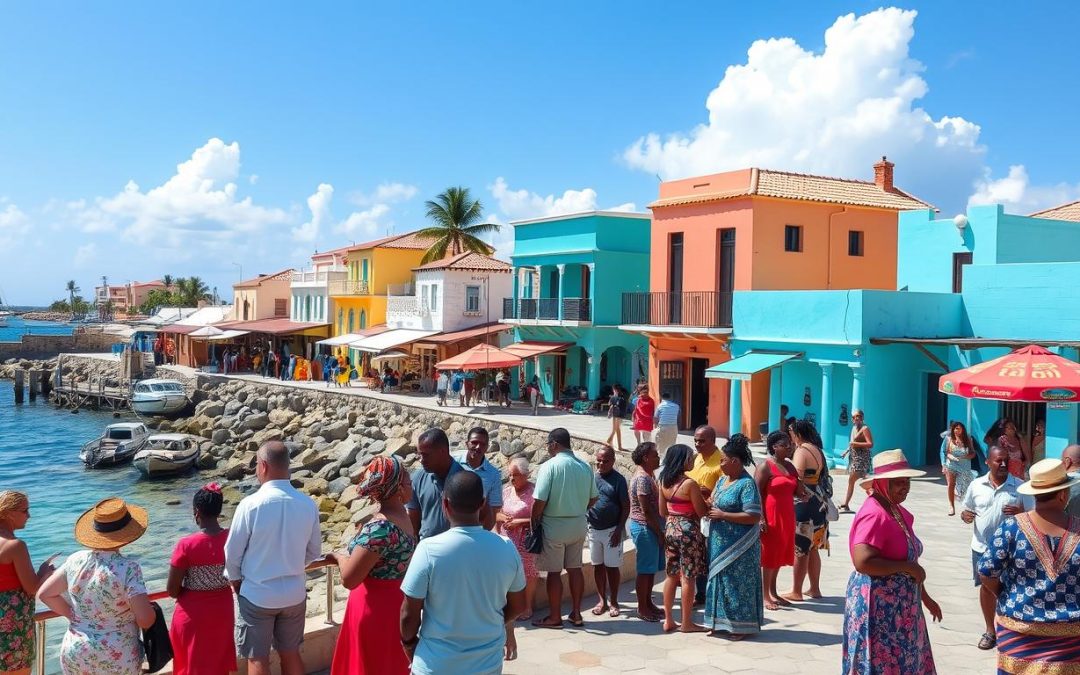Have you ever wondered how a small Caribbean island can speak four languages fluently? Aruba’s language scene is a colorful mix of communication. It shows the island’s rich culture and complex history.
In Aruba, languages are more than just words—they are living, breathing expressions of identity. The island’s official languages, Dutch and Papiamento, show a unique blend of historical influences. These have shaped its communication patterns for centuries.
Most Arubans are remarkable at switching between languages with ease. You’ll hear a mix of Papiamento, Dutch, English, and Spanish everywhere. This mix tells the story of this dynamic Caribbean nation.
Key Takeaways
- Aruba has two official languages: Dutch and Papiamento
- Most Arubans speak at least four languages
- Papiamento is the native tongue for almost all Arubans
- Language education starts early with English in 4th grade
- Spanish is spoken by approximately 44% of the population
Official Languages of Aruba
Aruba’s language scene is a colorful mix of its rich culture. The island’s official tongues tell a story of history and diversity. You’ll see how Papiamento and Dutch blend to form a special way of talking.
Dutch: The Language of Governance
Dutch is key for Aruba’s government and laws. It’s a leftover from colonial times but still important today. About 20% of government talks and legal papers are in Dutch, showing its big role.
- Used in government publications
- Essential for legal documentation
- Integral to official administrative processes
Papiamento: The Heartbeat of Aruban Culture
Papiamento is Aruba’s true native language, spoken by about 80% of people. It’s a mix of languages, showing the island’s diverse roots.
“Papiamento is more than a language – it’s the soul of Aruban identity”
| Language | Usage Percentage | Primary Context |
|---|---|---|
| Papiamento | 80% | Daily Communication |
| Dutch | 20% | Official Matters |
Historical Language Recognition
A big moment for Aruba’s language was on March 19, 2003. Papiamento was made a national language. This celebrated the indigenous language’s importance and Aruba’s effort to keep its language alive.
The mix of Papiamento and Dutch shows Aruba’s complex history. It creates a language world that is both useful and deeply meaningful to its people.
The Evolution of Papiamento in Aruba
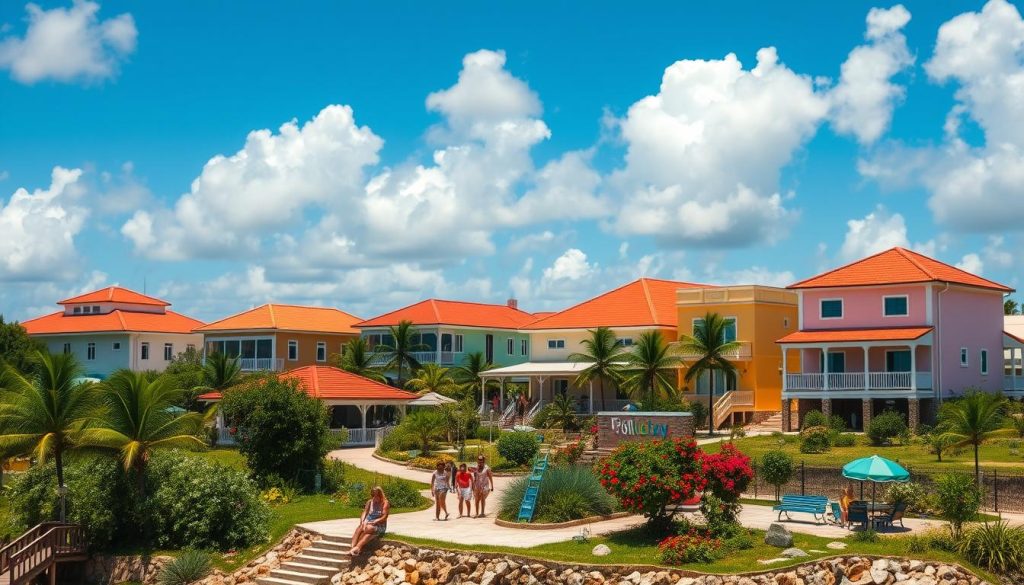
Papiamento is a unique language that shows Aruba’s rich culture. It started as a simple way to communicate and grew into a complex language. This change shows how Papiamento became a key part of Aruba’s culture.
The history of Papiamento goes back over 300 years. It was shaped by the cultural mix of the Caribbean. This mix included languages like Portuguese, Dutch, Spanish, African languages, and English.
About 80% of Papiamento’s words come from Spanish and Portuguese. This shows its deep roots in language history. By the 18th and 19th centuries, Papiamento became very important for talking among locals.
“Papiamento is not just a language, but a living testament to Aruba’s multicultural history.” – Language Historians
Important moments in Papiamento’s history include:
- The first newspaper, Civilisado, was started in 1871.
- The first book, “Catecismo Corticu”, was printed in 1837.
- Papiamento became an official language in 2003.
Now, Papiamento is still alive, with about 350,000 speakers in the ABC islands. It’s a strong symbol of preserving culture and identity.
Multilingual Education System
Aruba’s education system is a vibrant display of linguistic diversity. It shows how schools start teaching multiple languages early. This prepares students for the global job market.
Language Requirements in Schools
Aruban schools have a broad approach to language learning. Students learn several languages, including:
- Papiamento (native language)
- Dutch (official administrative language)
- English
- Spanish
Teaching Methods and Curriculum
The education system focuses on practical language skills. It uses innovative teaching methods. This ensures students get real-world communication abilities.
- Schools teaching in Papiamento achieve consistent graduation rates of 75% or higher
- Secondary school graduation rates range from 42% to 82%
- 94% of students do not encounter Dutch outside school settings
Foreign Language Integration
Aruba’s language learning strategy is not just in the classroom. Students learn practical language skills for tourism, business, and international communication. The curriculum focuses on:
- Practical language application
- Cultural context of language learning
- Multilingual competency development
“Language is the roadmap of a culture. It tells you where its people come from and where they are going.” – Rita Mae Brown
By embracing a multilingual education system, Aruba prepares its students for an interconnected world. It helps bridge cultural gaps through effective communication.
Spanish Influence and Usage
Spanish has become a vibrant thread in Aruba’s linguistic diversity. It weaves through the Caribbean languages with remarkable significance. The island’s proximity to South America has played a crucial role in embedding Spanish into the local communication landscape.
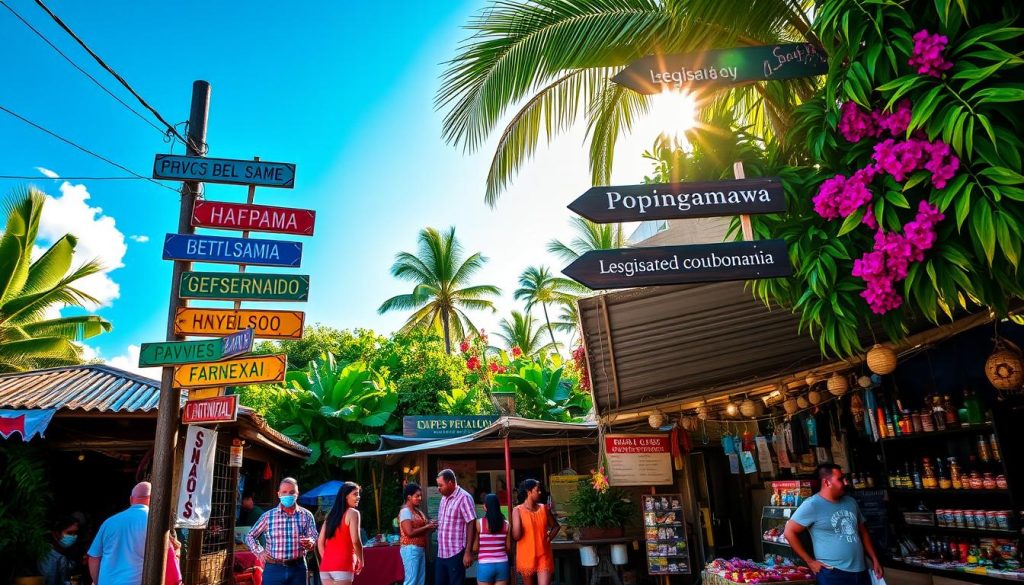
Exploring Aruba’s language dynamics will deepen your understanding. Since the 16th century, economic and cultural connections with Spanish-speaking regions have increased the language’s importance.
- Approximately 44% of Arubans speak Spanish fluently
- Spanish is introduced in schools starting from the fifth grade
- Close relations with South American countries strengthen Spanish usage
“Language is the road map of a culture. It tells you where its people come from and where they are going.” – Rita Mae Brown
The integration of Spanish reflects Aruba’s rich multicultural heritage. Students learn the language as a practical skill for regional communication and economic opportunities.
| Language Aspect | Spanish in Aruba |
|---|---|
| Introduction in Education | 5th Grade |
| Percentage of Speakers | 44% |
| Primary Influence | South American Economic Ties |
Your journey through Aruba’s linguistic landscape shows how Spanish blends with other languages. This creates a unique communication ecosystem that celebrates Caribbean linguistic diversity.
English as an International Language in Aruba
English is a key part of Aruba’s culture, connecting it to the world. It’s important for tourism and talking to people globally.
Historical British Influence
English came to Aruba in the early 1800s, during British rule. This early influence made English a vital part of the island’s culture. It became a bridge to the world, connecting Aruba to international markets and cultures.
Role in Tourism Industry
In Aruba’s tourism, English is crucial for communication. The island gets about 150 international flights a week. This means knowing English is key for visitors from all over.
English is widely used in:
- Hotels and resorts
- Tourist information centers
- Restaurants and entertainment venues
- Transportation services
Modern Usage and Importance
Today, English is a big focus in Aruban schools. Kids start learning English in the 4th grade. This prepares them for the world.
Most Arubans speak at least three languages, with English being a major one. This shows the value of language diversity.
“English connects us to the world beyond our beautiful island.” – Local Aruban Educator
English is more than just for tourism. It’s also key for business, education, and talking across cultures. Aruba’s focus on English shows its understanding of the world’s connections and the need for language skills.
Lesser-Known Languages in Aruba
Aruba is more than just its official languages. It has a rich mix of indigenous languages and multilingual communities. Dutch and Papiamento are common, but many other languages add to the island’s unique feel.
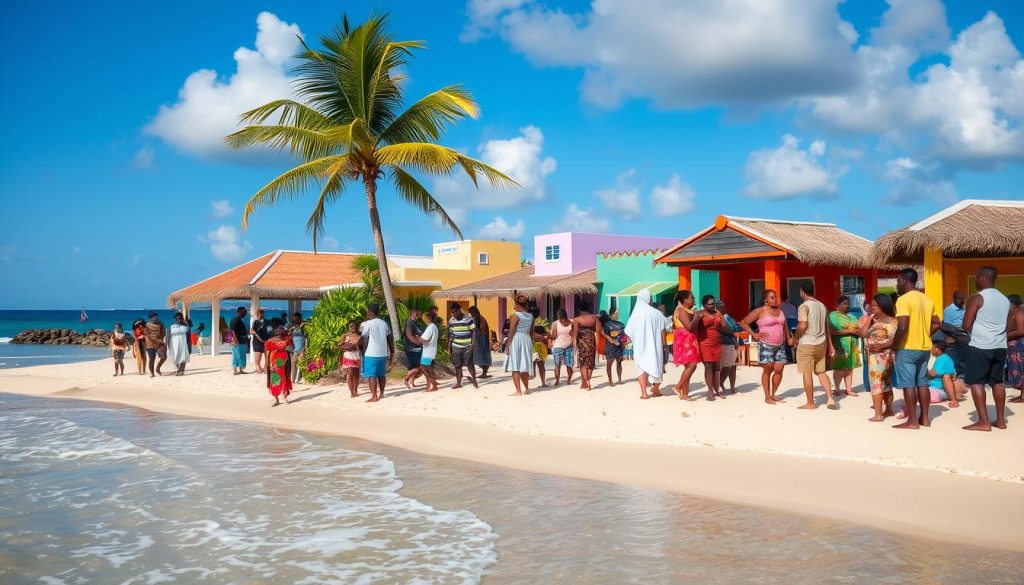
The island’s global connections shine through its language communities. You’ll find:
- Portuguese speakers
- Italian language communities
- German language groups
- Chinese language networks
- Haitian Creole speakers
- Tagalog-speaking populations
Aruba’s openness to the world is clear in its languages. Despite its size, it’s a hub for international communication and cultural exchange.
| Language | Estimated Community Size | Primary Origins |
|---|---|---|
| Portuguese | Small community | Brazilian immigrants |
| Chinese | Growing community | Asian immigration |
| Haitian Creole | Emerging group | Caribbean migration |
| Tagalog | Small diaspora | Philippine immigrants |
“Language is the roadmap of a culture. It tells you where its people come from and where they are going.” – Rita Mae Brown
Exploring Aruba’s languages shows a vibrant scene where many languages live together. These languages and communities highlight the island’s global ties and cultural depth.
Cultural Impact of Linguistic Diversity
Aruba’s language scene is a colorful mix of many tongues, making it a special place. This mix of languages is more than just talking. It helps people come together and share their culture.
Social Integration Through Language
Language is key in uniting Arubans. Almost 75% speak Papiamento, a language that brings people together. This diversity leads to interesting social interactions:
- Multilingual talks help everyone understand each other
- Different language groups learn to respect each other
- Cultural sharing happens easily through language
Cultural Expression and Identity
Aruba’s language shows its rich culture. Papiamento, in particular, is a source of national pride. About 55% of Arubans see it as essential to their identity.
“Language is the road map of a culture. It tells you where its people come from and where they are going.” – Rita Mae Brown
The island’s language scene shows how Caribbean languages shape identity. This happens in many ways:
| Language | Cultural Significance | Percentage of Speakers |
|---|---|---|
| Papiamento | National Language | 75% |
| Dutch | Official Administrative Language | 37% |
| English | Tourism and International Communication | 50% |
| Spanish | Regional Influence | 21% |
Every language adds to Aruba’s cultural mix. This shows how language diversity makes social life richer and keeps the island’s heritage alive.
Language Preservation Efforts
Aruba shows great respect for its cultural heritage and indigenous languages. The island works hard to protect and promote its linguistic diversity. This focus is especially on Papiamento.
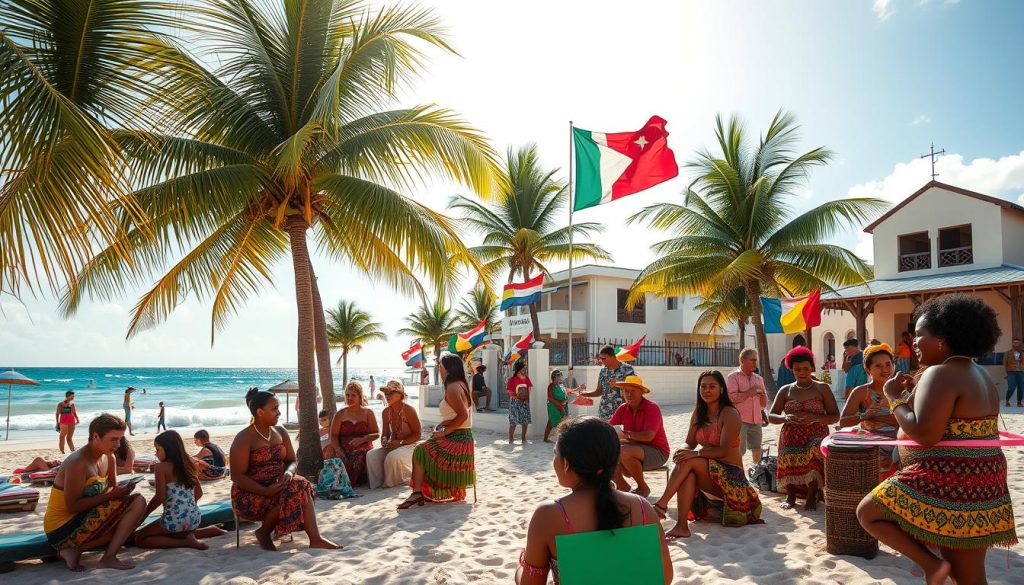
Government Initiatives
The Aruban government is committed to language preservation. They have launched several key initiatives. These include:
- Recognizing Papiamento as an official language
- Supporting digital preservation projects
- Collaborating with international organizations
The Coleccion Aruba project is a big achievement. It aims to digitize over a million pages of linguistic resources. The National Library of Aruba is leading this effort. They have created a vast digital archive for researchers and language lovers.
Community Programs
Local communities are vital in preserving languages. They have started grassroots programs to support Papiamento. These efforts include:
- Community language workshops
- Cultural events celebrating linguistic heritage
- Local media productions in Papiamento
Educational Resources
Schools are important for keeping languages alive. There have been recent developments. These include:
| Initiative | Description |
|---|---|
| School Curriculum | Integrated Papiamento language instruction |
| Digital Resources | Online language learning platforms |
| International Recognition | Inclusion in Meta’s “No Language Left Behind” initiative |
“Language is the roadmap of a culture. It tells you where its people come from and where they are going.” – Rita Mae Brown
These efforts show Aruba’s commitment to preserving its languages. They ensure future generations can connect with their rich cultural heritage.
Challenges and Opportunities in Aruba’s Linguistic Landscape
Aruba’s language scene is both challenging and full of opportunities. It’s a place where different languages come together, creating a unique society. This mix of languages makes communication complex but also rich.
In Aruba, people face the challenge of using multiple languages every day. The island has four main languages: Papiamento, Dutch, Spanish, and English. This means everyone must adjust how they talk to fit the situation.
- Papiamento is the native language.
- Dutch is used for official matters.
- Spanish and English are key in business and tourism.
But there are also great opportunities in this language-rich environment. People in Aruba become very good at speaking many languages. This skill is very useful in the global job market. Schools in Aruba also help students become multilingual.
“Language is the roadmap of a culture. It tells you where its people come from and where they are going.” – Rita Mae Brown
| Language | Percentage of Speakers | Primary Usage |
|---|---|---|
| Papiamento | 65% | Daily Communication |
| Dutch | 25% | Official/Administrative |
| Spanish | 15% | Regional Trade |
| English | 40% | Tourism |
Aruba turns language challenges into chances for cultural exchange and personal growth. Being able to speak many languages is a valuable skill in this lively Caribbean setting.
Conclusion
Your journey through Aruba’s linguistic landscape shows a fascinating story of cultural resilience and adaptation. Around 92% of the population speaks Papiamento as their first language. This makes Aruba a standout example of Caribbean linguistic diversity.
The island’s multilingual environment is unique. Here, 90% of students learn in multiple languages. This highlights Aruba’s special way of communicating.
The linguistic richness of Aruba is more than just talking. It’s a vibrant way to show cultural identity and history. Dutch is used in official settings, while Papiamento is common at home. Spanish and English add to this mix, showing Aruba’s global connections and adaptability.
Understanding Aruba’s languages gives us a deeper look into its social dynamics. A whopping 75% of Arubans have positive views on speaking multiple languages. This openness helps keep cultural heritage alive and opens doors for international connections.
Aruba’s linguistic journey shows that language is more than just a way to communicate. It’s a living, breathing part of the island’s history, resilience, and future. The mix of languages shows Aruba’s ability to respect its roots while embracing the world.
The above is subject to change.
Check back often to TRAVEL.COM for the latest travel tips and deals.
Here are some Tours & Sightseeing suggestions that might pique your interests!
